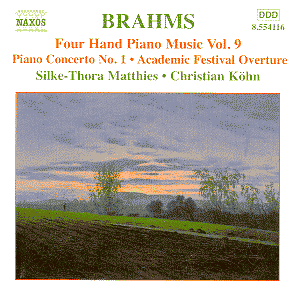These arrangements are not included in Brahms’
collected complete works; they were produced by Robert Keller,
and then, to an unspecified degree, "corrected" by Brahms.
Even with performers skilled and committed as these are, the first
movement of the piano concerto does not come off awfully well
in this format. As you might expect there are lots of pounding
chords and heavy growling piano tremolandos imitating the
orchestra. Those passages in the original where the playing of
a motif by the orchestra is contrasted by the same motif played
by the piano here become merely repetitions. A wider stereo perspective
would have helped here, separating the two pianos right and left,
providing spatial contrast to compensate for lack of textural
contrast, but the perspective on this recording is tight, with
the two pianos both centred.
Although I am often very positive in my reviews
of piano reductions of orchestral music, I was about to write
this disk off until the slow movement began, and — what a wonder!
The adagio comes off very beautifully here, as if it were Brahms’
finest piano sonata! No wonder he very nearly left the work in
this form, instead of proceeding to orchestrate it. Here a wider
stereo stage wouldn’t have helped and might have been distracting.
The last movement is much more successful than
the first because here the orchestral part is less "monumental"
and the pianos have an easier time of simulating it. The Academic
Festival Overture is a more rhythmic and incisive work than
most conductors play it, so it actually benefits from piano reduction
and comes across quite well.
It is important to point out that these are piano
duets, not four hands on one piano as the cover suggests. The
distinction is important: in a "four hands" at a single
keyboard arrangement, somebody plays all the high notes and somebody
else plays all the low notes. The notes in between have to be
fought over. While there may be some communicative advantage in
the two pianists rubbing against each other frequently while playing,
from the technical musical standpoint this distraction could only
detract from the accuracy of the music. In a piano duet version
both pianists can play high notes and both pianists can play low
notes at the same time without restriction and counterpoint in
one register can be played as elegantly as need be by all four
hands. Communication is usually accomplished sufficiently by having
the pianists sitting facing each other, although some piano duo
teams are seated side by side.
Paul Shoemaker
